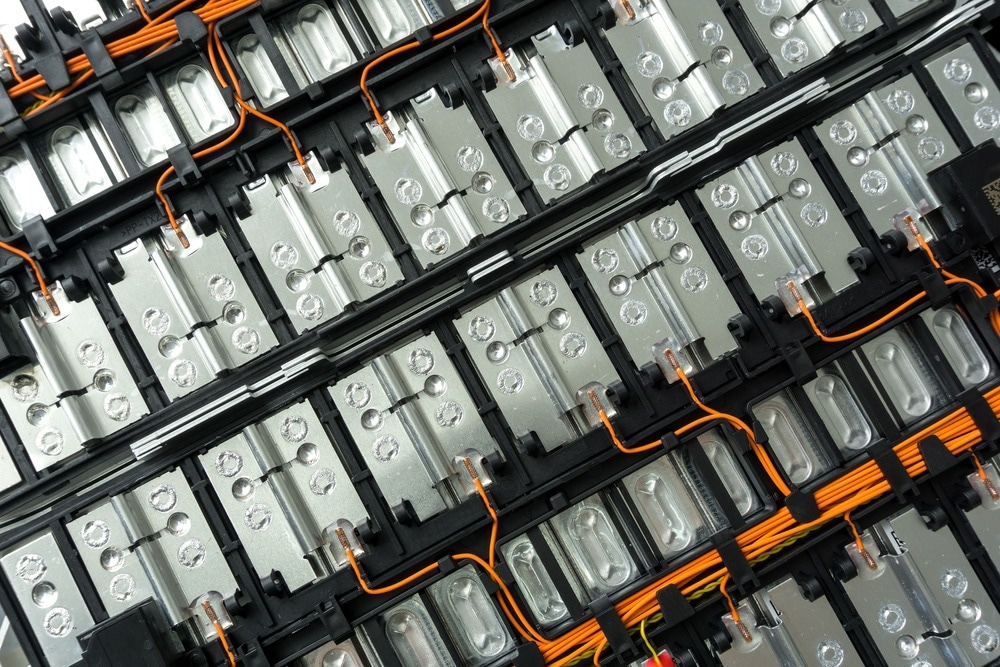Stress relaxation due to structural fluctuations in silicon (Si) is critical for its application in lithium-ion batteries (LIBs). In an article published in the Journal of the Electrochemical Society, mesoporous silica (SiO2) spheres were reduced using magnesium silicide (Mg2Si) to achieve nanoporous Si particles. The fabricated Si particles were applied as anode material for all-solid-state LIBs.

Study: High Cycle Stability of Nanoporous Si Composites in All-solid-state Lithium-ion Batteries. Image Credit: Smile Fight/Shutterstock.com
Compared to the non-porous Si half-cells, the prepared nanoporous counterparts exhibited outstanding cyclability with approximately 90% retention capacity at 50 cycles in all-solid-state LIBs. Moreover, analytical methods, including electrochemical impedance spectroscopy (EIS) and field emission scanning electron microscopy (FE-SEM) equipped with energy-dispersive X-ray spectroscopy (EDX), helped compare the characteristics of non-porous and nanoporous Si composite anodes.
The results confirmed that the contraction and expansion of Si pore in the nanoporous Si anode material and the elastic deformation of the lithium phosphorous sulfide (Li3PS4) relieved the structural stress caused by the volume changes of Si aggregates during lithiation and delithiation process, which resulted in the high cycle stability. As a result, the potential of Si-based anodes in all-solid-state LIB was established.
Replacement of Conventional LIBs with All-Solid-State LIBs
LIBs are robust alternative energy storage systems used for electric vehicles. However, graphite is not a suitable anode material to meet the energy demand in advanced automobile technologies due to its limited specific capacity. Although Si is a suitable material for automobile applications, its anode form has poor cycling capacity.
The storage and release of lithium ions (Li+) lead to volume fluctuations in LIBs, causing electrochemical disadvantages. To this end, previous studies on liquid electrolyte-based LIBs mentioned two approaches for relieving the Si anode’s structural stress, namely, nanosizing and compositing.
For example, previous studies mentioned that stainless steel substrate-based Si nanowires with sufficient spaces could withstand the volume changes in LIBs. Moreover, mesoporous Si nanospheres with hollow inner voids supported the internal expansion and contraction during volume changes of Li+ ions.
The all-solid-state LIBs comprise a solid electrolyte instead of a liquid one. One of the most important benefits of solid-state electrolytes is that they never carry the safety issues of liquid electrolytes. The all-solid-state LIBs are one of the most promising replacements for conventional LIBs due to their wide operable temperature range, inherent high safety, and high energy density.
Thus, developing all-solid-state LIBs that are safe and flexible, have a stable output voltage, and have good air atmosphere manufacturability is highly desirable for powering automobile technology. However, studies on all-solid-state LIBs with Si anodes are more limited than those on LIBs using liquid electrolytes.
Nanoporous Si Composites in All-Solid-State LIBs
In the present work, a simple and cost-effective nanosizing process was adopted to facilitate the Si anode’s volume expansion. Nanoporous Si particles were prepared using Mg2Si-based reduction of SiO2 fumes or via atmospheric oxidation of Mg2Si. The as-prepared nanoporous Si particles were used as anode material, a novel approach for all-solid-state LIBs.
Additionally, Li3PS4 solid electrolyte was used to fabricate composite anodes in all-solid-state LIBs. Optimization of nanoporous Si particle size, pore distribution, and surface area was critical since the electrode’s microstructure strongly affected the performance of all-solid-state LIBs.
Compared to atmospheric oxidation of Mg2Si, the oxygen supply was restricted for SiO2 under vacuum conditions. Thus, it is critical to obtain higher-purity Si particles with fewer surface oxides. Moreover, the SiO2 spheres have well-distributed pore channels. Nanoporous Si, a reduction product of the SiO2 spheres, was developed to investigate the role of porous structure on electrochemical properties.
Analytical methods including EIS, FE-SEM-EDX were employed to investigate microscopic structures and electrochemical behavior of nanoporous Si composite anodes for all-solid-state LIBs. The results indicated that the nanoporous structure of Si mitigated the volume change of Si aggregates in composite anodes, where the Si volume expansion was buffered by nanosized pores shrinkage.
Furthermore, the stress from Si expansion was relieved by the solid electrolyte’s elastic deformation in all-solid-state LIBs. This deformation of the solid electrolyte returned to its native state and retained its contact with Si aggregates.
Conclusion
Overall, the improved cycle performance of all-solid-state LIBs using nanoporous Si particles provided information on the importance of Si-based anodes in automobile technology. The present study represented a critical step in developing high-performing all-solid-state LIBs.
Through the present work, improvements in Coulombic efficiency and capacity were achieved for the practical application of Si composite anodes in all-solid-state LIBs. The increased capacity helps construct a new conduction path for dispersed Si aggregates in the composite anode.
Despite the limited supply of an oxygen source to SiO2, the X-ray photoelectron spectroscopy (XPS) profile indicated the presence of Si oxides on the inner and outer sides of the Si nanospheres. This was suppressed by enhancing the Coulombic efficiency using mechanical milling or photoetching under vacuum.
Reference
Okuno, R., Yamamoto, M., Kato, A., Takahashi, M. (2022). High Cycle Stability of Nanoporous Si Composites in All-solid-state Lithium-ion Batteries. Journal of The Electrochemical Society. https://iopscience.iop.org/article/10.1149/1945-7111/ac81f6
Disclaimer: The views expressed here are those of the author expressed in their private capacity and do not necessarily represent the views of AZoM.com Limited T/A AZoNetwork the owner and operator of this website. This disclaimer forms part of the Terms and conditions of use of this website.